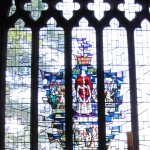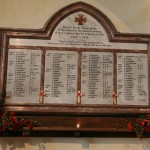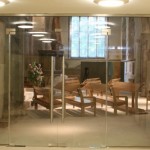THE WEST END
1. The font is Medieval, possibly Norman. It was mounted on a plinth which has 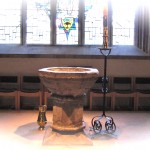 been removed as it was a trip hazard. The water drains away directly into the ground and not into the drains as it is consecrated water.
been removed as it was a trip hazard. The water drains away directly into the ground and not into the drains as it is consecrated water.
2. The great West window or Gilpin window.
This window depicts some of the stories from the life of Bernard Gilpin, Rector of Houghton from 1557 till 1583. The stories shown in the window are:
a. Founder of the Kepier Grammar School. This building is located behind the church and remained a school until the 1920s. It was one of, if not the first, school in the North of England. It educated children from the minor nobility and Gilpin himself would keep and educate local lads he came across who showed promise, even sending them on to Oxford.
b. Father of the poor. Gilpin was very generous. On most Sundays he held open house, feeding any who called, rich or poor. He is said to have given away his cloak, and at one time even his horse, to those in need.
c. Apostle of the North. In Gilpin’s time Northumberland was a wild and fierce borderland, home of the Border Reivers. Very few churches had clergy, most Rectors living away and only returning once a year to collect rents and tithes. Into this vacuum Gilpin would visit churches in places like Rothbury and there preach the Gospel, marry, baptise and bury a people starved of spiritual comfort. This was no mean thing and not without danger.
d. The boar and oak tree crest is the shield of the Gilpin family, later adopted by Houghton Urban District Council.
e. The picture of the horse refers to the episode of the plough lady being given Gilpin’s horse after her own had died.
Continue clockwise to the NORTH WALL OF THE CHURCH
1. A nice little piece of interest: in the second window from the servery Jesus is depicted wearing what looks like a cowboy hat. Children enjoy it.
2. The War Memorial is from WW1. The names are not the same as those on the cenotaph outside. These are names of people known to the congregation of the time.
3. Under the memorial, in a case, is the Houghton le Spring Book of Remembrance for WW II.
4. The window facing the main door was once a doorway known as The Devil’s Door. In the past children were brought in through this door before Baptism, and so also were the dead in their coffins. This was to signify coming from darkness [the North] into church and leaving afterwards via the South door into the light [the South] and sunshine.
5. A tower was added to the West end of the Saxon church by the Normans. This was burned down by Black Douglas of Scotland, (or James the Good, depending on which side of the border you live) in 1319. The foundations were discovered during the recent excavations part of which are preserved next to the column by the sound desk.
6. There is a plaque next to the last window on the north aisle dedicated to Jane Bowes Barrington who is believed to have been a relative of the late Queen Mother, Elizabeth Bowes Lyon.
7. The meeting room, formerly the Lady Chapel. On the walls inside the meeting room are a number of interesting plaques. The one near the door is to William Ironside—perhaps the street was named after him? On the North wall there is a small wooden door: this covers an aumbry, presently not used. On the East wall is a niche with a hole in the bottom: this is known as a piscina and is for disposing of holy [blessed] water.
MEZZANINE HERITAGE CENTRE
There is much information here;
1. The table/altar is circa 1600. this is thought to have been used by the Puritans as an altar. Dates on the Rectors Board list two intruders in 1645. These would have been the Puritan equivalent of Rectors.
2. One of the old Victorian pews is preserved –1857/58.
3. A folder of photographs of the church before, during and after excavations and reordering in 2008.
4. A Saxon doorpost holder can be seen. This was found under the floor during excavations
5. Detailed reports and pictures of the history of the church on video and displays.
6. Photographs and pictures of previous Rectors. Note that St. Michaels is the only church in England to have had two Rectors who went on to become Archbishops of Canterbury—these are: 1758 Thomas Secker and 1677 William Sancroft.
THE CROSSING and TOWER.
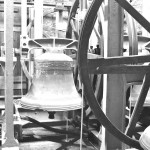 The decorative wood ceiling marks the base of the central tower, which houses a very impressive set of bells and the ringing room. The lead on the roof was graffitied by choir boys in Victorian times. We are always looking for new bellringers, let us know if you might be interested.
The decorative wood ceiling marks the base of the central tower, which houses a very impressive set of bells and the ringing room. The lead on the roof was graffitied by choir boys in Victorian times. We are always looking for new bellringers, let us know if you might be interested.
Continue up to the CHANCEL and HIGH ALTAR
1. The Organ. This was made in Durham by the world famous Harrison and Harrison in 1932.
2. The Choir Stalls were installed by Rector Grey around 1860 when the church was last reordered by the renowned Newcastle architect John Dobson
3. The large cupboard is an aumbry, still used to keep the reserved Sacrament, that is: consecrated bread and wine used for Home Communions. The red light signifies the Sacrament is present inside.
4. The small window featuring St. Michael, is Norman although the glass is later.
5. The Houghton Beasts/Dragons.
This carving is thought to predate the church and may have been brought here from elsewhere. Some of the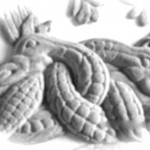 explanations of the dragons are:
explanations of the dragons are:
- the struggle in heaven between Satan and God; Satan being thrown down to Earth
- the struggle between Northumbria and the Norse invaders
- they are not fighting but embracing, thus signifying the meeting between the Celtic Church with the Roman Church, culminating in the Council of Whitby—take your pick.
6. Note the small red cross painted on the wall next to the last window on the North side. This is a consecration cross and marks the spot where holy water is sprinkled to keep out evil. This was done at all windows and doors when the church was first opened, it is therefore over 900 years old!
7. The Great East window. This window was commissioned and paid for by Sir George Elliot, Bart., himself a colourful and interesting character. He is entombed in a vault in the church’s detached burial ground, known as the old Hillside Cemetery, at the top of Houghton Cut. He rose from a boy working in the local colliery to owning mines and engineering companies, one of which laid the first transatlantic cable. His representation can be seen at the bottom of the window, the only person without a halo as he was still alive at this time. The two girls in the bottom right are believed to be twin sisters, nieces of Sir George Elliot, who died in a house fire. Unusually, King Charles 1 is represented fourth from the left at the bottom. More information is available on the other people in the window. Can you identify the saints? Can you find Bernard Gilpin?
8. The eight lancet windows depict the story of Holy week. These windows were removed for safe keeping during World War Two and two were reputed to have been put back the wrong way round.
9. There is a tomb in the South wall. This is of Marjorie Bellasis, who was a friend and supporter of Bernard Gilpin. How the tomb comes to be in the middle of a wall is a mystery. The Marjorie Bellasis brass is now on the wall next to the Gilpin Tomb in the Gilpin transept. Marjorie died aged 90 years, her husband having died when she was 32. Lucky for her as she already had 12 children. She lived in Morton House, which is situated on the small lane between the Chilton Hotel, Fencehouses and the Fence Houses War Memorial.
THE GILPIN TRANSCEPT
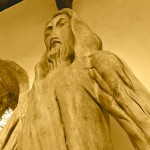 1. The sculpture is of The risen Christ, spiralling up to heaven, by Fenwick Lawson. It is sculpted from one twisted tree trunk, Lawson’s work includes pieces exhibited on Holy Island, St. Paul’s Jarrow, Durham Cathedral and in the square opposite The Gala Theatre in Durham.
1. The sculpture is of The risen Christ, spiralling up to heaven, by Fenwick Lawson. It is sculpted from one twisted tree trunk, Lawson’s work includes pieces exhibited on Holy Island, St. Paul’s Jarrow, Durham Cathedral and in the square opposite The Gala Theatre in Durham.
2. The Gilpin Tomb dominates this trancept and is the resting place of Rector Bernard Gilpin. This was originally located in the chancel near the high altar. Rector Gilpin died on the 4th March 1583 after being knocked over by an ox in Durham market place.
3. The two small gravestones are known as “the twins” and were in the
graveyard outside covering two children’s graves, possibly twins—perhaps the girls depicted in the East window?
4. There are two knight’s effigies in the trancept: one thought to be Sir John le Spring, a Norman knight who took his name from Houghton. The other is of Sir Roland Bellasis of Morton Grange who was knighted and fought for King Henry III against Simon de Montford at the Battle of Lewis 1264
5. In this transept is our Book of Remembrance where families remember those who have died. This is a quiet place to pray and remember; perhaps light a candle for a loved one and leave a prayer on the tree.
7. The window which depicts St. John is dedicated to Sir William Standish Standish of Cocken Hall. He is entombed in the Hillside Cemetery. It is his vault that keeps getting broken into and vandalised; he is also the man who supposedly rode his horse over the cliff—this is very doubtful as he died at home. He was very well connected with both the English and French Royal families.
8. On the south aisle, mounted on the wall, is a miner’s lamp, presented to the Church when Houghton Colliery closed in 1981.
There is much more detailed information about the church and community of Houghton-le-Spring on information boards around the church and in the Heritage Centre
**********
Compiled by David Turnbull.

